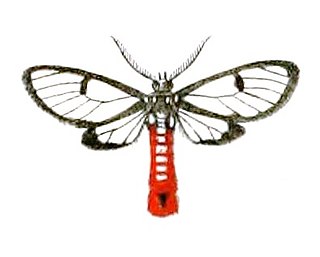Related Research Articles
Aner refers, in the Hebrew Bible, to:
Anērān or Anīrân is an ethno-linguistic term that signifies "non-Iranian" or "non-Iran" (non-Aryan). Thus, in a general sense, 'Aniran' signifies lands where Iranian languages are not spoken. In a pejorative sense, it denotes "a political and religious enemy of Iran and Zoroastrianism."

The Argentine North Eastern Railway (ANER) was a British-owned railway company, founded in 1887, that operated a 1,435 mmstandard gauge railway network in the provinces of Entre Ríos, Corrientes and Misiones in Argentina. When the company was nationalised in 1948 it became part of the state-owned General Urquiza Railway.

Clystea is a genus of moths in the subfamily Arctiinae. The genus was described by Watson in 1980.
In the mathematical field of infinite group theory, the Nottingham group is the group J(Fp) or N(Fp) consisting of formal power series t + a2t2+... with coefficients in Fp. The group multiplication is given by formal composition also called substitution. That is, if
Clystea daltha is a moth of the subfamily Arctiinae. It was described by Herbert Druce in 1895. It is found in Pará, Brazil.
Clystea dorsilineata is a moth of the subfamily Arctiinae. It was described by George Hampson in 1898. It is found on Jamaica and Cuba.
Clystea frigida is a moth of the subfamily Arctiinae. It was described by Hermann Burmeister in 1878. It is found in Argentina.
Clystea fulvicauda is a moth of the subfamily Arctiinae. It was described by Arthur Gardiner Butler in 1896. It is found in São Paulo, Brazil.
Clystea jacksoni is a moth of the subfamily Arctiinae. It was described by William James Kaye in 1925. It is found in Trinidad.
Clystea lepida is a moth of the subfamily Arctiinae. It was described by Max Wilhelm Karl Draudt in 1915. It is found in French Guiana.
Clystea leucaspis is a moth of the subfamily Arctiinae. It was described by Pieter Cramer in 1775. It is found in Venezuela, Bolivia and Brazil.
Clystea paulista is a moth of the subfamily Arctiinae. It was described by Max Wilhelm Karl Draudt in 1915. It is found in Brazil.
Clystea platyzona is a moth of the subfamily Arctiinae. It was described by Felder in 1869. It is found in Colombia.
Clystea sanctula is a moth of the subfamily Arctiinae. It was described by Paul Dognin in 1911. It is found in Brazil.

Clystea sarcosoma is a moth of the subfamily Arctiinae. It was described by Arthur Gardiner Butler in 1876. It is found in Colombia.
Clystea serrana is a moth of the subfamily Arctiinae. It was described by Schaus in 1928. It is found in Brazil.
Clystea stipata is a moth of the subfamily Arctiinae. It was described by Francis Walker in 1854. It is found in Pará, Brazil.
Clystea tenumarginata is a moth of the subfamily Arctiinae. It was described by William James Kaye in 1919. It is found in Guyana.
References
- ↑ Beccaloni, G.; Scoble, M.; Kitching, I.; Simonsen, T.; Robinson, G.; Pitkin, B.; Hine, A.; Lyal, C., eds. (2003). "Clystea aner". The Global Lepidoptera Names Index . Natural History Museum . Retrieved April 30, 2018.
| This Arctiinae-related article is a stub. You can help Wikipedia by expanding it. |